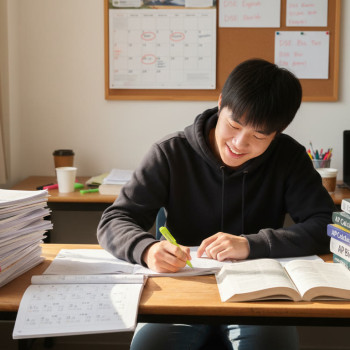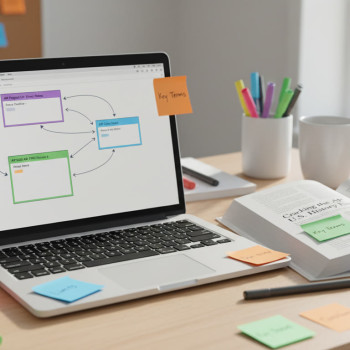Handling Procrastination Compassionately: A Parent’s Guide to Helping Your AP Student Thrive
Watching your child put off studying for AP classes can feel like standing at the edge of a friendly cliff: you see the fall, you want to shout advice, and you’re terrified of pushing too hard. If that’s you, take a breath. Procrastination isn’t a moral failing — it’s a behavior with reasons behind it. This guide is written for parents who want to help without turning study time into a battleground. It blends empathy, practical tools, and real-world strategies so your teen can learn, grow, and succeed on their own terms.

Why Teens Procrastinate (And How That Changes the Way You Help)
Procrastination shows up for many reasons, and understanding which apply to your teen helps you respond more constructively.
Common causes
- Overwhelm — AP classes cover a lot of material; when the mountain looks too high, teens freeze.
- Perfectionism — fear of not doing it perfectly can lead to doing nothing at all.
- Unclear next steps — vague study goals are hard to start.
- Motivation gaps — the connection between effort now and outcomes later isn’t always obvious to young people.
- Executive function differences — planning, organizing, and prioritizing are skills still developing in adolescence.
What compassion looks like
Compassion is not permissiveness. It’s understanding the emotion or barrier at play and responding with curiosity instead of anger. For example, instead of saying, “Why haven’t you started?” try, “What’s the smallest next step you feel okay doing right now?” That invites collaboration and reduces shame, which is a major driver of procrastination.
Practical Steps to Reduce Procrastination: A Compassionate Playbook
Below are concrete, parent-friendly strategies you can try immediately. Mix and match; no single technique works for every student.
1. Start with small, specific actions
Vagueness is an enemy. Ask your child to identify a tiny, concrete task: read one page, outline one paragraph, complete five practice problems. Micro-goals lower the starting friction and create momentum.
2. Use an action-first approach
Encourage a 10- to 20-minute “do it now” session. Studies on the Zeigarnik effect and momentum show that initiating a task makes completion likelier. Frame it as an experiment: “Let’s try 15 minutes and see how you feel afterward.”
3. Build a visible plan together
Create a shared, realistic study map for AP units and exam timelines. Use a calendar or whiteboard and mark short, achievable targets. Visual plans turn abstract pressure into manageable checkpoints.
4. Schedule but keep it flexible
Set regular study windows—short and consistent beats infrequent marathon sessions. Allow swaps within the week so your teen still feels agency and control.
5. Teach prioritization with a simple matrix
Help them separate urgent tasks from important ones. This reduces the tendency to get lost in low-impact busywork.
6. Reduce friction and distractions
- Designate a study spot with minimal distractions.
- Consider short phone-free sessions or an app that temporarily blocks distracting sites.
- Prepare materials in advance so starting doesn’t require hunting for supplies.
7. Reframe failure as feedback
When your teen struggles on a practice exam or a difficult assignment, label it: feedback. Celebrate the data—what went wrong, what can be adjusted—and then map the next small step. This reduces shame and builds a growth mindset.
Communicating in Ways That Actually Motivate
How you talk matters more than what you say. Tone and timing can turn a helpful suggestion into pressure. Here are communication tips that maintain connection while moving the work forward.
Curiosity beats control
Ask open-ended questions: “What part of the AP course feels most confusing?” or “Which assignment would make you feel more confident if it were done?” Curiosity signals partnership.
Use “when/then” language
Link rewards or privileges to completed actions in a non-coercive way: “When you finish your review for 30 minutes, then we can watch the show together.” This clarifies expectations without ultimatums.
Model calm problem-solving
If you react with frustration, your teen may mirror it and shut down. Breathe, acknowledge the emotion (“I know this feels heavy”), then propose one tiny step forward.
Hands-On Routines That Build Consistency
Routines reduce decision fatigue. You don’t need perfect structure—just predictable rhythms that help study become automatic.
Sample weekly rhythm
Here’s a flexible example you can customize to your family’s schedule.
| Day | Focus | Time | Outcome |
|---|---|---|---|
| Monday | Short review of notes | 25 minutes after school | Clarify 2 confusing points |
| Wednesday | Practice problems | 30–40 minutes | Complete 10 targeted problems |
| Friday | Mock quiz or flashcards | 20 minutes | Identify 3 weak topics |
| Weekend | Longer study block with breaks | 60–90 minutes | Deep work on one unit |
Small, consistent blocks beat sporadic all-nighters. The goal is incremental progress and sustainable habits.
Tools That Help — Without Overwhelming
There are many ways to support study beyond pep talks. Pick a few that fit your teen’s style.
- Checklists for each study session so your teen can mark progress.
- Pomodoro timers to structure focused intervals and brief breaks.
- One-page summary sheets for each unit — building these is studying.
- Practice tests to make the abstract concrete and reduce test anxiety.
Note: if your child needs more individualized support, options like Sparkl’s personalized tutoring can be a game-changer. Tutors provide 1-on-1 guidance, tailored study plans, and expert help to turn confusion into clarity. When combined with routines at home, that kind of focused support often accelerates progress.
When to Provide Extra Support (And How Much)
Parents often wonder how involved they should be. Too little and your teen may flounder; too much and they won’t develop ownership. Use these signals to decide when to step in.
Signs your teen needs help
- Consistent avoidance despite trying small steps.
- Marked anxiety or physical symptoms tied to studying.
- Slipping grades with unclear reasons.
- Executive function struggles (losing materials, missed deadlines).
How to step in constructively
- Offer to co-design a study plan, but let them choose elements.
- Support scheduling by setting aside a distraction-free window at home.
- Arrange for targeted help (tutor, teacher conference) and present it as an opportunity, not a punishment.
When tutoring is the right fit, prioritize tutors who emphasize skills and confidence-building rather than “just more practice.” Personalized tutoring like Sparkl’s (with expert tutors and AI-driven insights) can tailor learning to specific gaps and make study time more efficient and less stressful.
How to Encourage Motivation Without Nagging
Motivation comes in two flavors: extrinsic (grades, rewards) and intrinsic (mastery, satisfaction). Short-term motivation often needs extrinsic nudges, but your long-term goal is to help your teen experience intrinsic rewards: the pride of understanding, the relief of preparedness, and the independence of self-directed study.
Practical nudges
- Publicly celebrate small wins: a completed practice test or a focused study session.
- Encourage reflection: after a study session, ask, “What helped you concentrate today?”
- Help them connect effort to outcomes: track practice scores over time so improvement is visible.
Examples: Realistic Parent Scripts
Words matter. Here are short scripts you can adapt. They keep the tone compassionate, concrete, and collaborative.
When your child says, “I’ll do it later”
Parent: “Okay. Do you want to pick a 20-minute slot for tonight, or shall I set a timer for 15 minutes now and we’ll check in afterward?”
When they’re overwhelmed by a large project
Parent: “This looks huge. Want help breaking it into three chunks? We can plan one chunk for tonight—what feels doable?”
When you notice avoidance
Parent: “I noticed you haven’t started the review yet. I’m not here to make you do it, but I can sit with you for 20 minutes while you get going if that helps.”
Measuring Progress: Simple Metrics That Encourage Growth
Progress is motivational when it’s visible. Pick 2–3 indicators and track them consistently for a month.
| Metric | How to Track | What It Shows |
|---|---|---|
| Study Sessions Completed | Cross off sessions on a calendar | Consistency and habit formation |
| Practice Test Scores | Record percent or section scores weekly | Knowledge gains and areas needing focus |
| Time to Start | Note minutes between scheduled start and actual start | Procrastination trends |
Celebrate upward trends. If time-to-start shrinks or practice scores improve, point it out: “I see your Thursday scores went from 68% to 78%—that’s progress!” Recognition reinforces effort.
Balancing Empathy with Boundaries
Compassion doesn’t mean removing all structure. Clear boundaries with predictable consequences help your teen learn responsibility while feeling supported.
Example boundary framework
- Expectation: Study sessions happen X times per week.
- Support: Parents will help set study space and remove distractions during those times.
- Consequence: Missed sessions result in a check-in conversation and a revised plan—no punitive escalation unless deadlines are chronically missed.
This framework signals that you’re on the same team, not the enforcement squad.
When to Consider Professional Help
If procrastination is severe, tied to anxiety or depression, or your teen appears chronically disengaged, professional evaluation is appropriate. Therapists, school counselors, or clinical psychologists can help differentiate between motivational struggles and underlying mental health concerns. If learning differences or executive functioning disorders are suspected, a formal assessment can open doors to accommodations that make AP work more accessible.
Final Thoughts: Growth Over Grades
AP preparation is a marathon of learning, not a sprint of perfection. When parents approach procrastination with curiosity, structure, and kindness, they teach their teens something far more valuable than any score: how to tackle big tasks when they’re scared, tired, or unsure. Those skills—self-awareness, planning, and resilient effort—serve for life.
If you’re ever unsure where to start, remember that help can be incremental: a short study plan, a single tutor session, or even fifteen minutes of focused work today can reset momentum. For many families, combining home routines with targeted, personalized tutoring (like Sparkl’s 1-on-1 guidance and tailored study plans) turns procrastination into progress.

Be patient with yourself and your teen. Celebrate small wins. And trust that with compassion, strategy, and a few practical tools, procrastination becomes less of a problem and more of a stepping stone toward confident, independent learning.
Quick Checklist for Parents
- Start with curiosity, not blame.
- Break big tasks into 10–20 minute micro-goals.
- Build a visible, flexible study plan together.
- Use consistent short sessions over occasional marathons.
- Track 2–3 progress metrics and celebrate improvements.
- Consider personalized tutoring for targeted support.
You’re not alone in this. With a compassionate approach, an emphasis on small wins, and practical support when needed, your AP student can learn to manage procrastination and discover the confidence that follows true mastery.




















No Comments
Leave a comment Cancel